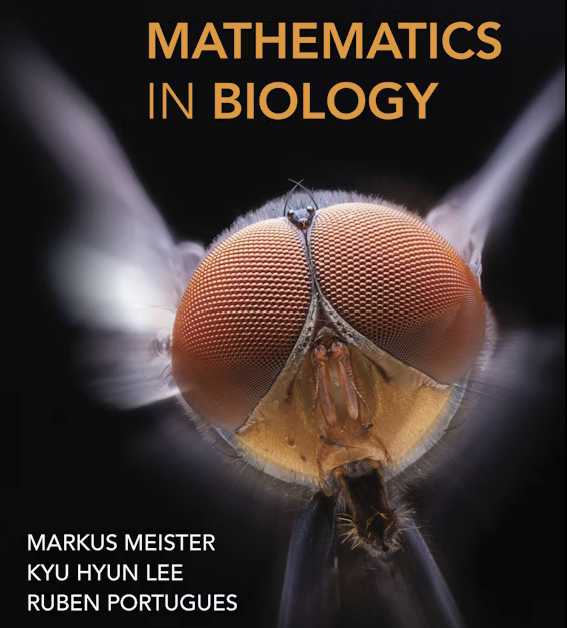
Comments about the book:
"Compact and elegant. Particularly welcome are straightforward discussions of filtering and other signal processing, optimal estimation, and fold change detection, all of which are hard to find in an accessible presentation at this level."
Philip Nelson, Professor of Physics, University of Pennsylvania; author of Physical Models of Living Systems: Probability, Simulation, Dynamics, second edition"This fun, interesting, and insightful book represents a creative reimagining of how to teach mathematics not only to biologists but to natural scientists more broadly. The authors provide a clear and no-nonsense approach to many, many topics that one needs to know in order to engage with using mathematics in the natural sciences. I will undoubtedly come back to this book again and again."
Rob Phillips, Fred and Nancy Morris Professor of Biophysics, Biology, and Physics, California Institute of Technology; author of Physical Biology of the Cell"The tools of mathematical analysis are of increasing importance for the study of biological systems. This excellent book puts these tools directly into the hands of its readers. Read it and start using them."
Larry Abbott, William Bloor Professor of Theoretical Neuroscience, Columbia University; coauthor of Theoretical Neuroscience"This book serves up an appetizer menu of a ‘quantitative minimum’ for budding biologists of all ilks, with flavorful applications across scales, from optimal filtering and estimation to neural dynamics."
L. Mahadevan, de Valpine Professor of Applied Mathematics, Physics and Organismic and Evolutionary Biology, Harvard University"Mathematics is the language of proteins, cells, and tissues as it is of atoms, circuits, and stars. In this essential book, Meister, Lee, and Portugues empower all biologists to use that language to understand the living world."
Michael B. Elowitz, Synthetic Biologist and Roscoe Gilkey Dickinson Professor, Caltech; Investigator, Howard Hughes Medical Institute
This is the website that accompanies the textbook Mathematics in Biology, published by MIT press. Here you can access various resources by selecting the menus above.
We also provide a sample chapter, Chapter 8: Advanced Topics in Probability and Statistics.
You can read why we decided to write this book HERE.
BOOK CONTENTS
- Prerequisites
- ▶ 1. Elements of Calculus
- 1.1 Elementary Functions
- 1.2 Differentiation
- 1.3 Integration
- 1.4 Differential Equations
- 1.5 Multiple Variables
- 1.6 Complex Numbers
- 1.7 The Delta Function
- Part I. Linear Systems
- ▶ 2. Basics of Linear Algebra
- 2.1 Motivation
- 2.2 Vector Space
- 2.3 Basis Sets
- 2.4 Linear Operators
- 2.5 Matrix Algebra
- 2.6 Change of basis
- 2.7 Scalar Product
- 2.8 Special Matrix properties
- 2.9 Eigenvalues and Eigenvectors
- 2.10 The Characteristic Equation
- 2.11 Diagonalizing a Matrix
- ▶ 3. Linear Systems
- 3.1 Linear Systems Analysis
- 3.2 Fourier Transforms
- ▶ 4. Applications of Linear Systems
- 4.1 Microscopy
- 4.2 Crystal Analysis
- 4.3 X-ray Scattering
- 4.4 Detecting Periodicity
- 4.5 Filtering
- 4.6 Sampling
- 4.7 Optimal Estimation
- ▶ 5. Exercises
- Part II. Probability and Statistics
- ▶ 6. Basics of Probability and Statistics
- 6.1 Motication
- 6.2 Events and Probabilities
- 6.3 Discrete Random Variables
- 6.4 Continuous Random Variables
- 6.5 Multiple Random Variables
- 6.6 The Central Limit Theorem
- ▶ 7. Inference and Statistical Testing
- 7.1 Maximum Likelihood Estimation
- 7.2 Bayesian Estimation
- 7.3 Hypothesis Testing
- 7.4 The z-test
- 7.5 The t-test
- 7.6 Goodness of Fit to a Distribution
- 7.7 Nonparametric Tests
- 7.8 Other Statistical Tests
- 7.9 Linear Regression
- 7.10 Bootstrapping
- ▶ 8. Advanced Topics in Probability and Statistics
- 8.1 Random Walks and Diffusion
- 8.2 Random Time Series
- 8.3 Hidden Markov Models
- 8.4 Point Processes
- 8.5 Dimensionality Reduction
- 8.6 Information Theory
- ▶ 9. Applications of Probability and Statistics
- 9.1 Luria-Delbrück Revisited
- 9.2 Signal Processing
- 9.3 Population and Quantitative Genetics
- 9.4 Vision at the Quantum Limit
- 9.5 Neural Coding
- ▶ 10. Exercises
- Part III. Nonlinear Dynamics
- ▶ 11. Basics of Dynamical Systems
- 11.1 Motication
- 11.2 What Is a Dynamical System?
- 11.3 Flows, Fixed Points, and Bifurcations
- 11.4 Dynamics in Two Dimensions
- 11.5 Bifurcation Analysis of 2D Systems
- ▶ 12. Advanced Topics in Nonlinear Dynamics
- 12.1 Dynamics in Three or More Dimensions
- 12.2 Chaos
- 12.3 The Turing Model of Morphogenesis
- ▶ 13. Applications of Nonlinear Dynamics
- 13.1 Repressilator
- 13.2 Fold Change Detection
- 13.3 Bistability
- 13.4 Turing Patterns
- 13.5 Circadian Rhythms
- 13.6 How Do Neurons Communicate?
- ▶ 14. Exercises
Figures: There are over 200 figures, most of which were generated using python. You can find the code in Jupyter Notebooks that have been uploaded to the Github repository linked above.
Errata: We are collecting a (hopefully short) list of errata. If you find an error, please email us at contact"at”mathinbio.com.
Solutions to exercises: We encourage you to send us your solutions to the exercises in the book (again email contact"at”mathinbio.com). We will select the best and publish them on the "Solutions" page with author credit.
Sample curriculum: We suggest a sample curriculum for a full year or semester course HERE. It follows 20 lectures based on Bi195 at Caltech.
 Mathematics in Biology
Mathematics in Biology